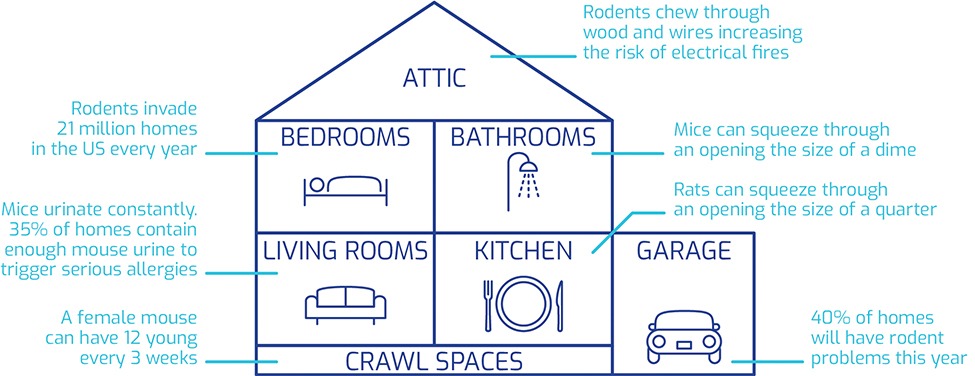PUBLIC
HEALTH
Rodent control services are a matter of public health. Rats and mice are exploding in population around the world. Rodents spread diseases like salmonella and introduce disease causing pests to homes and businesses. Rodent infestations are most commonly reported in the fall and winter (more than 20 million U.S. homes are invaded by rodents each winter); however, spring and summer follows a close second with only a ~15% decrease in reported rodent issues then during fall and winter. Regardless of the season, rodents can pose threats to your home, business, or public building.
Hearing Noises in the Attic?
Rodent control services is not just about dealing with and eliminating a nuisance pest or a pest that can cause serious structural damage. Rodents pose a public health and safety issue for people occupying structures that are plagued by rodents. Eco- Safe understands this important detail and we are proud to invest in the education, certification, and training of our team as pest control and public health go hand in hand. After inspecting your home or business, Eco-Safe will design a rodent treatment plan that will get you the results you desire. It is important to note that Eco-Safe does not rely on “cookie cutter” approaches when it comes to rodent control services. Our goal is to address all of our customers’ concerns and provide peace of mind for all Eco-Safe clients.
There are five main rodents that plague the United States: House mice, Deer mice, Cotton rats, Norway rats, and Roof rats. Each of these rodent species are responsible for spreading serious diseases and causing hundreds of millions of dollars of damage each year in the United States.
Rodents pose health risks associated with hantavirus, salmonella, allergies, asthma, tularemia, plague, rat bite fever, flea-borne typhus, lymphocytic choriomeningitis, and leptospirosis. Rats and mice are exploding in population around the world. Worldwide, rats and mice are accountable for spreading at least 35 diseases.
Humans can be infected with rodent-borne diseases through many different ways, such as contact with rodent feces, urine, saliva and bites. Making matters even worse, rodent diseases are also spread to humans indirectly. Pests, such as ticks, mites, and fleas, can spread rodent-borne diseases to humans if they previously fed on an infected rodent.
In addition to the threat of disease, rodents are responsible for an innumerable amount of damage to structures. Rodents are known to enter vulnerable homes and businesses where they reproduce, produce waste, contaminate food and surfaces, and continuously gnaw. Rodents can chew through wood and electrical wires which can lead to fires. A single mouse will constantly urinate, produce 25,000 droppings a year, and can have as many as 12 young every three weeks if it is a female. It is important to know that rodents are cryptic creatures. In some cases, you may be unaware of a rodent issue until significant damage has been done.
Pest Exclusion Is Pest Prevention and Pest Prevention Is Public Health.
It’s no mystery that rodents are incredibly unsanitary and damaging. Whether you notice signs of rodent activity or are interested in stopping rodent activity before it starts, you can trust the original and only RatBusters®.
Whether you’re new to utilizing a pest control service or already have a pest control company and desire better results and/or safer methods, we invite you to put your trust in Eco-Safe. Noises in the attic and gnaw marks are clear signs you should call the professionals at Eco-Safe. Our evaluations are free and with over 50 years of successful results, we pride ourselves on our ability to offer the highest quality service for the most affordable price. Call or click today to get your free inspection scheduled.
Rodent Invasion Facts


RODENT
PROOF
Eco-Safe offers complete rodent proofing and monitoring services. Our proven system stops rodents from entering your home or business,
with guaranteed results!



